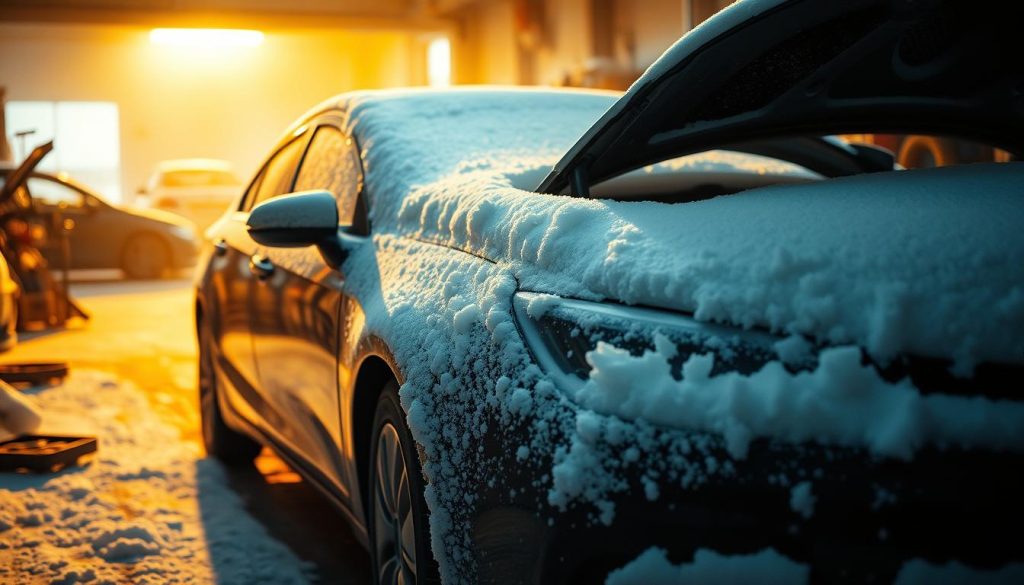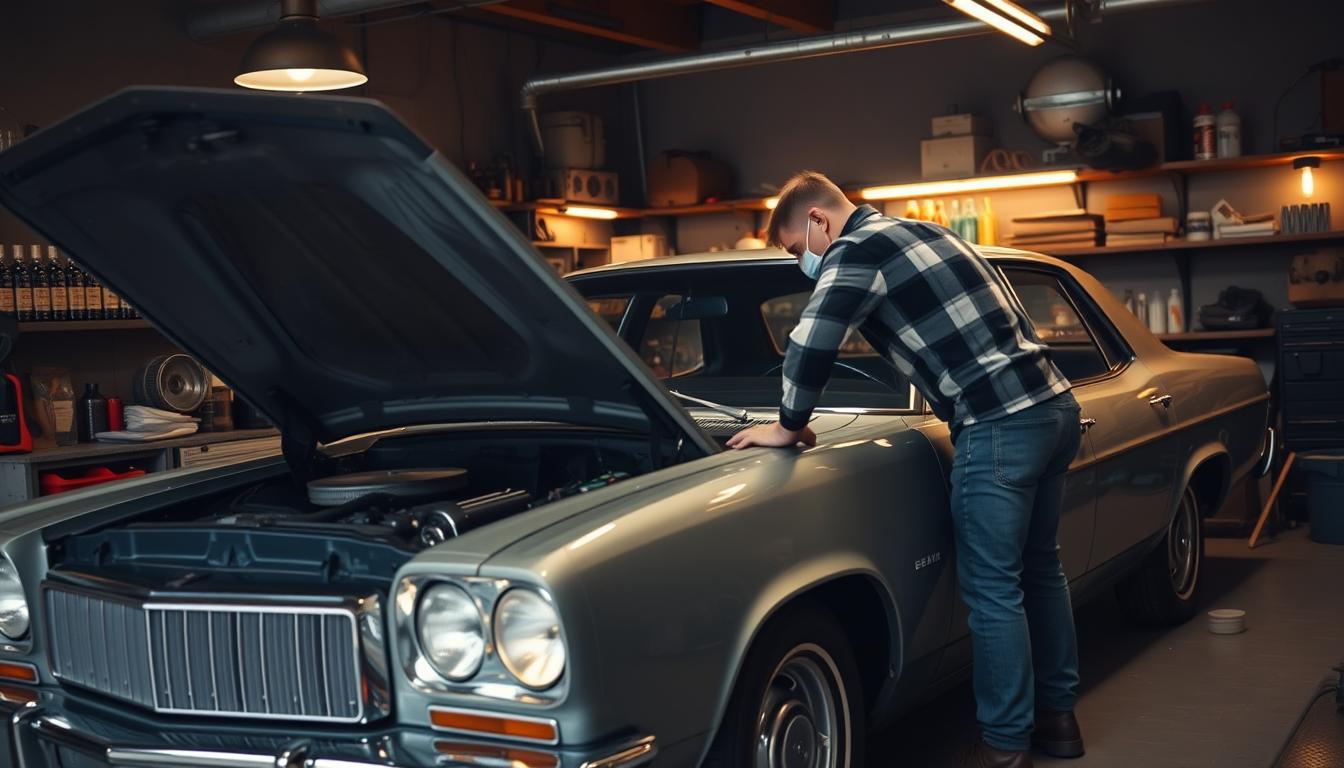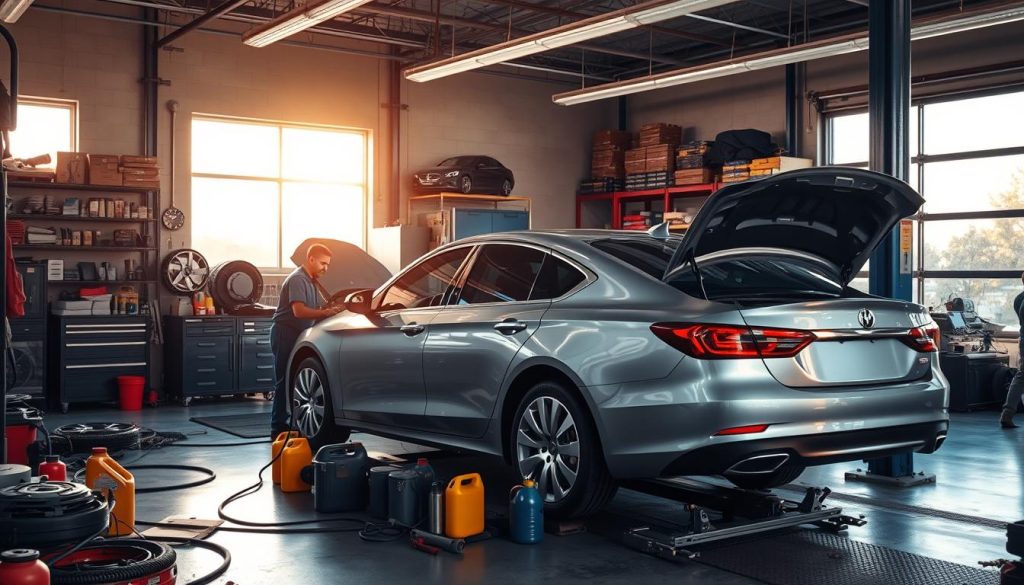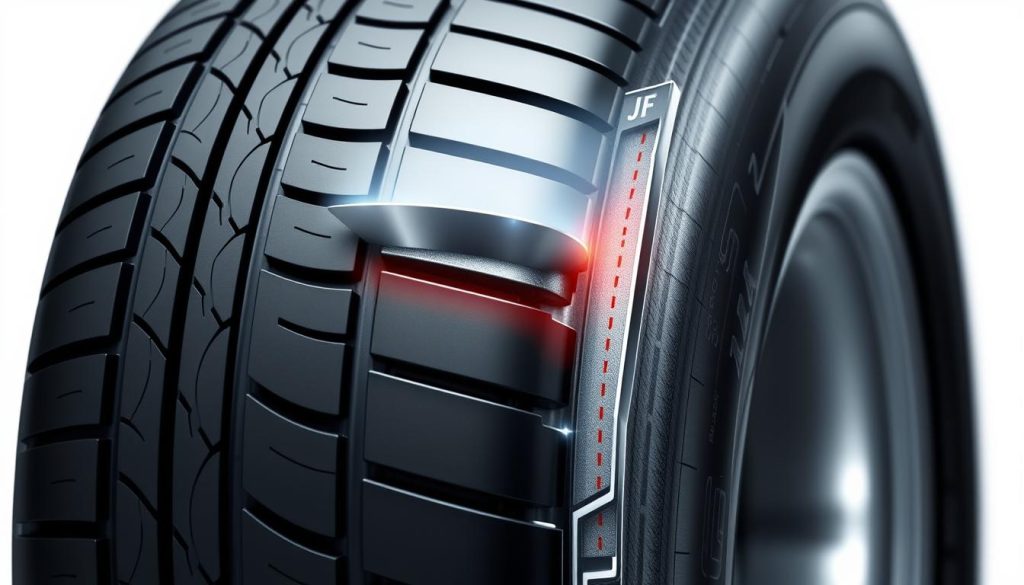Winter is coming, and we must make sure our cars are ready. Cold weather can hurt our cars in many ways. We need to know how to keep them running well.
Things like battery power and tire grip get worse in the cold. By getting our cars ready for winter, we can avoid problems. This makes driving safer and faster on icy roads.
In this article, we’ll talk about how to make driving better in winter. We’ll cover important car checks and upgrades. Our aim is to help you keep your car safe and strong during winter.
Key Takeaways
- Cold weather demands a specific coolant-to-water ratio for optimal engine performance.
- Winter tires are designed to outperform all-season tires in temperatures below 45°F.
- Regular battery checks are critical; higher cold cranking amps ensure reliability in winter starts.
- Maintaining proper tire pressure is essential, as it decreases with falling temperatures.
- An emergency kit stocked with essential supplies can enhance safety during winter travel.
Importance of Winter Car Maintenance
Winter is coming, and we need to get ready. We must make sure our cars are safe and work well. If we don’t, our cars might not run right and we could get into accidents.
Understanding Cold Weather Effects on Your Vehicle
Cold weather hurts our cars in many ways. For example, tires get softer in the cold. This makes it harder to control our cars on snowy roads.
Batteries also get weaker in the cold. A battery that’s over three years old is even more at risk. We must check our batteries often to avoid problems.
Why Regular Maintenance Matters in Winter
Keeping our cars in good shape is very important in winter. Using special oils helps our engines run better in the cold. We also need to keep the right mix of antifreeze and water to avoid engine damage.
Most winter accidents happen because cars aren’t well-maintained. So, it’s very important to check our cars before winter starts.

Essential Winter Car Maintenance Checks
Getting our cars ready for winter is key. We need to check the battery and tires. Cold weather makes batteries work less well, making it hard to start the car.
Checking tires is also very important. Good tires with enough tread and air keep us safe on icy roads. Let’s look at what we need to do to get our cars ready for winter.
Battery Performance and Testing
Cold weather makes batteries work slower, up to 50%. If your car is over three years old, test the battery. This helps avoid car troubles.
Checking the battery’s voltage is important when it gets cold. It tells us if we need a new battery. Keeping the battery working well is a must for winter.
Tire Inspection and Preparation
Winter tires are very important in cold weather. They help us stop and turn better on icy roads.
It’s also key to check tire pressure often. Cold weather can make it drop. Keeping the right pressure and checking tread depth helps us stay safe.
Preparing Your Car’s Fluids for Winter
In winter, we must prepare our car’s fluids well. This ensures our car works great and stays reliable. We focus on antifreeze, engine oil, and windshield washer fluid. Keeping these fluids right helps avoid breakdowns and keeps us safe.
Antifreeze Levels and Quality
It’s key to check our engine coolant’s antifreeze levels. The right mix is usually 50/50, but check your car’s manual. Checking weekly helps our engine run well in cold. The right mix keeps the engine from freezing and boiling too fast.
Engine Oil Considerations for Cold Weather
Choosing the right engine oil for winter is important. Synthetic oil works better in cold and lasts longer. It keeps our engine safe and running smoothly, even when it’s cold.
Windshield Washer Fluid Selection
Winter makes it hard to see because of snow and ice. We need to pick a windshield washer fluid that won’t freeze. Winter washer fluids have special stuff to keep them from freezing and clean icy windshields. Always fill up our washer fluid in winter.

Tools and Supplies for Effective Winter Maintenance
Having the right tools and supplies makes winter car prep easier. We can fix common problems and stay safe on the road. Here are the must-have tools and supplies for winter driving.
Must-Have Tools for DIY Maintenance
Winter tools help us deal with many issues. These include:
- Shovel: A small shovel is key for snow removal.
- Ice Scraper: It’s vital for ice on windshields.
- Snow Brush: It clears snow from the car’s body.
- Jumper Cables: They help start a dead battery.
- Traction Aids: Kitty litter or sand improves icy traction.
- De-icers: They quickly thaw frozen locks and windshields.
- Flashlight: A strong flashlight, like the Energizer, is great for dark nights.
Recommended Winter Driving Supplies
Winter driving supplies are also important for safety and comfort. Key items include:
- Winter Tires: Vredestein Wintrac Pros or Bridgestone Blizzaks offer great traction.
- Tow Strap: A good tow strap, like the Rhino USA, is useful without a tow truck.
- Emergency Kit: The Kosin Survival Kit has tools for emergencies and is durable.
- First Aid Kit: The Swiss Safe First Aid Kit is key for quick injury care.
- Warm Clothing: Extra winter clothes, wool socks, and insulated boots keep us warm.
- Hand Warmers: HotHands keep fingers warm while driving.
- Camping Blanket: A camping blanket in the car keeps us warm at stops.
- Warning Devices: Road flares and other tools are vital for safety at incidents.
With these tools and supplies, we’re ready for winter. Our cars are safer, and driving is better.
Tips for Safe Winter Driving
Winter is coming, and we need to know how to drive safely. Every year, many crashes happen because of winter storms. Over 2,000 people die in these accidents, says the AAA Foundation for Traffic Safety.
We must change how we drive and get ready for winter. This will help us stay safe and keep others safe too.
How to Handle Icy Road Conditions
When roads are icy, we should go slow and brake smoothly. AAA says to slow down and leave more space behind us. This helps us stop safely and avoid accidents.
If we get stuck, it’s best to stay in our car. It’s warm and easy for rescuers to find us.
Best Practices for Winter Commutes
Plan our routes before winter hits. This helps us avoid delays from bad weather. It’s also smart to keep our gas tank full.
Make sure our exhaust pipe is clear and check our car often. This helps us avoid accidents and stay safe.
Emergency Preparedness for Winter Driving
Being ready for emergencies is key in winter. Keep a first-aid kit, blankets, snacks, and a flashlight in our car. Winter tires can make driving safer by up to 50%.
By following these tips, we can drive safely in winter. We protect ourselves and others on the road.



